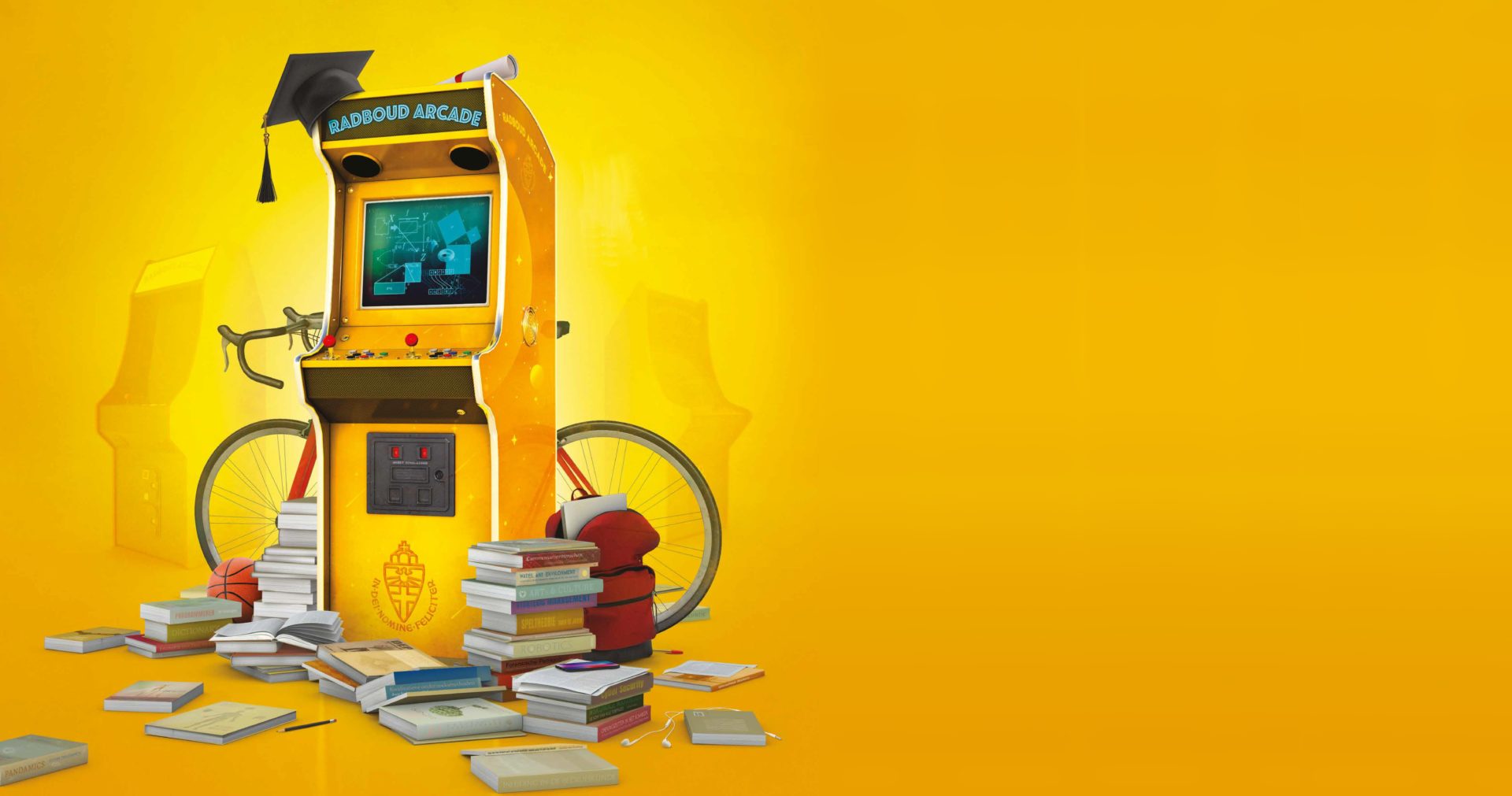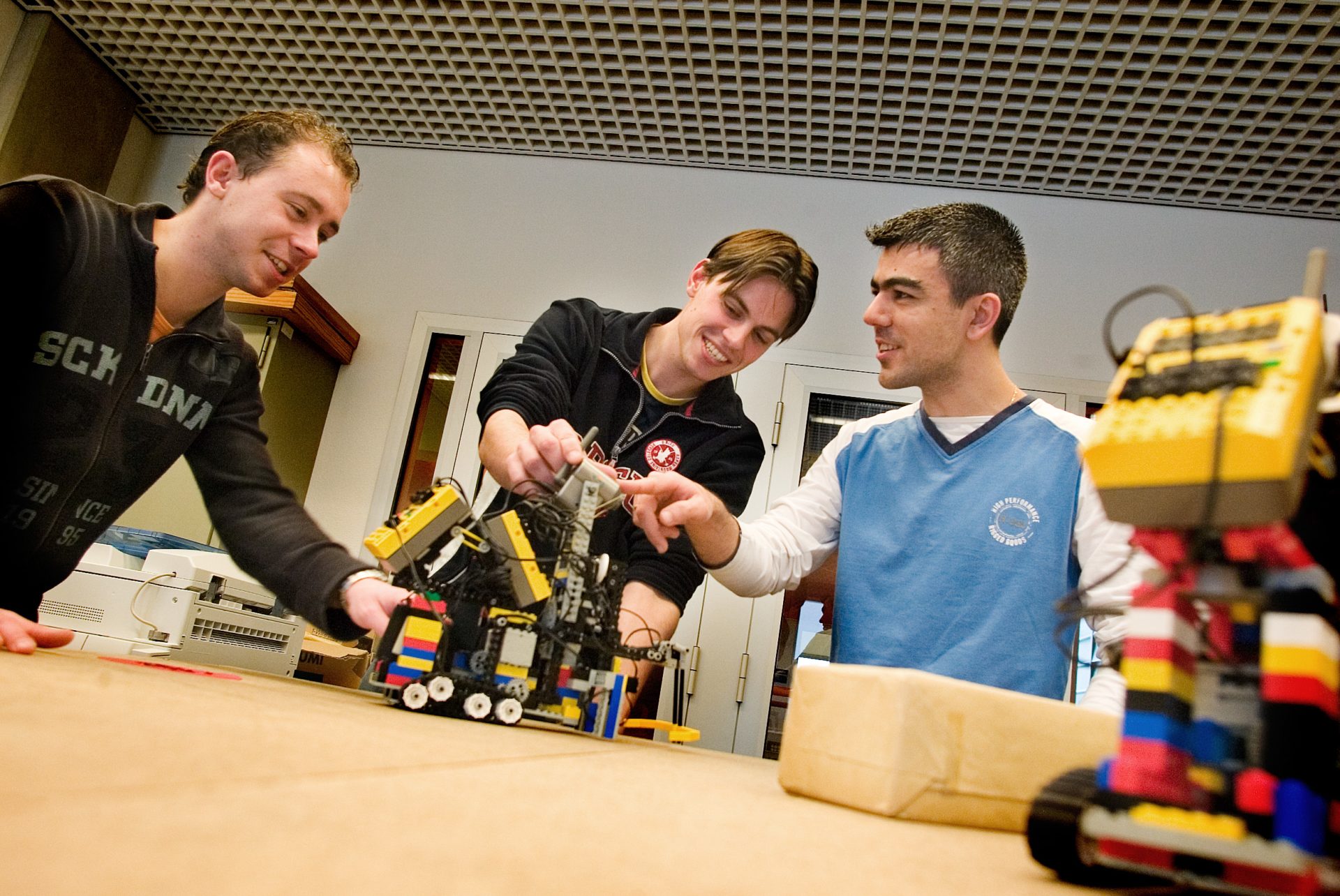Gamification in education is more than just a game
-
 Illustratie: JeRoen Murré
Illustratie: JeRoen Murré
Games are no longer just for fun. In teaching for example, game elements are increasingly used to improve motivation and learning among students and pupils. But does gamification actually work?
Sell as much iced tea and sports drinks as possible. That’s the goal of the management game played by first-year Business Administration students. As fictive managers of a large company, students work in teams to solve a number of dilemmas, ultimately leading to them breaking the bank or going bankrupt.
‘There are so many variables that students can adjust and experiment with,’ says Nanne Migchels, Assistant Professor in Business Administration. ‘They come up with a brand and formulate a business plan. They decide on the price of their product, their marketing budget and where the drinks will be sold.’
For lecturers, it’s great fun every year to see how fanatical many students become about the game. Migchels: ‘In other years, students would spend whole days brainstorming about it together, usually ending up at the Cultuurcafé. Some groups even had jumpers printed with their company logo.’ This year the game took place online because of COVID-19.
But the management game is not only for fun. The underlying purpose is serious: make students aware of the game played in big companies. ‘We train our students to be able to position elements within an organisation and make good decisions,’ says Migchels.
In his opinion, a lot ‘goes wrong’ in the corporate world, mostly due to the fact that the managers in charge don’t have a good overview of what is happening within the company. ‘Everything’s connected. The investments you make, the people you deploy, your product delivery. We use the game to help students gain insight into this complexity.’
For most people, the word ‘game’ brings to mind video games, especially since the COVID-19 pandemic, which resulted in young people spending even more time on their game console or smartphone. In particular games with a social component, like Fortnite, were used to compensate for the lack of parties, team sports and other social activities.
‘Gamification is certainly no hype’
But games have also become ubiquitous in education, with the Business Administration game being just one example. Another one is the course in Robotics offered by the Artificial Intelligence programme, in which students learn to program a robot vehicle to independently complete an obstacle course – a bit like Perseverance Rover exploring Mars. Then there is the Evidence Based Medicine course offered by the Faculty of Medicine, in which PhD students use a game to learn to adopt a reliable scientific approach to formulate a diagnosis and treatment plan.
This raises the question of how useful game elements like this are in education. Do they really, as is often claimed, improve knowledge transfer and motivation or is it all a hype, possibly driven by the growing popularity of video games among the young?
LinkedIn profile
‘Gamification is certainly no hype,’ laughs Frank Leoné. ‘It’s been around forever. The only thing that’s new is the label we put on it,’ says the neuroscientist, who also works at the Radboud Teaching and Learning Centre.
To clarify what he means, Leoné first feels the need to put something straight: although gamification in education is often compared to deploying games that serve a useful purpose, it is in fact a much broader phenomenon.
Gamification is about applying game elements to something that is not a game – which could be anything. ‘Think of the progress bar on your LinkedIn profile, which fills up as you add data to your profile. Or savings stamps.’ The goal is to give people the feeling that they’re making progress and doing something meaningful. This has a motivating effect.
‘Games have traditionally been designed to appeal to our motivation, which is why they’re useful in teaching.’ The secret, says Leoné, is to take the students’ experience and emotions as the starting point in designing teaching, rather than the lecturers. ‘We call this human-centred design.’
Deploying game elements in a balanced way – digitally or without technology – can make teaching more stimulating, explains Leoné. ‘Our current education system relies too much on fear of loss. You have to do your best, otherwise you get a poor mark – that’s the basic idea. This may give pupils the feeling that they’re not making any progress. Say you first get an 8 in a maths test, and then a 6 on your next test: you may feel as if you’re regressing, although you probably know more than you did at first. It’s kind of strange when you stop to think about it.’
What Leoné tries to do, for example in the Academic and Professional Skills course he teaches for the Artificial Intelligence programme, is to reward progress. ‘Ideally, I’d have students start a course with a 0 and earn points throughout the course, in the form of a progress bar. Unfortunately, it’s not so easy to implement in Brightspace.’

In this way, a game element can help students develop a different, more positive attitude. Leoné: ‘Teaching works best when students are motivated. Before the COVID-19 crisis, this was to some extent happening automatically, because of the other students in the classroom. This effect has partly been lost now, but if we design our teaching based on the students’ experience, we can use game elements to keep their motivation high.’
Nanne Migchels adds that gamification in education helps not only to increase motivation, but also to acquire new knowledge. ‘It’s a good addition to cognitive learning. University teaching often involves students opening their mind, us pouring knowledge into it, and them closing the lid. The experience they acquire in our management game helps them gain new insights. It’s an eye-opener.’
Adverse effect
Pedagogical Sciences expert Erik Meester is more sceptical about the benefits of gamification. Meester – what’s in a name? – has studied learning and development for years, mainly in primary education. A former school teacher himself, since 2019 he has been working as primary education developer at the Pedagogical Sciences department. Meester’s interest in games goes way back. As a teenager, he used to play StarCraft and World of Warcraft at competition level, he explains. ‘Then I decided to become a teacher and I thought: we have to use games for absolutely everything.’
These days, he takes a slightly more nuanced stance. ‘Whether you offer materials via gamification or in a traditional manner, pupils ultimately have to acquire the same knowledge,’ he says. ‘Game elements or no game elements, the complexity of a maths problem remains the same.’
‘Game elements can keep our motivation high’
Of course, he says, game elements can help with motivation, but ultimately, the most important thing is the experience of success. When pupils see that they understand the materials, their interest increases, as does their motivation to learn more.
How about the use of game elements to support the learning process, for example hints that help pupils remember something, or a progress bar? These are certainly useful, says Meester, but a purpose-driven approach and challenging tasks is not really a novelty in education. ‘A teacher also makes progress palpable by saying: Last time we counted up to 10; today we’ll be counting up to 20. So, in a sense, gamification is simply new wine in old bottles. It’s not really a game changer.’
If gamification is to succeed, certain conditions must be met, says the pedagogical sciences expert. It is important not to bypass everything else we know about teaching and learning. ‘The most important thing is that game elements should support the learning process and not simply increase involvement.’ Randomly turning everything into a game with all sorts of bells and whistles may have an adverse effect, with the game distracting pupils from the ultimate goal: learning. ‘This is also what research shows.’
Tigers and lions
Frank Leoné agrees with Erik Meester that didactic insights should form the basis for how game elements are used in teaching. Form and content should support each other. ‘Otherwise, you’re just creating a kind of chocolate-covered broccoli: a trick to cover up something unpleasant.’
This substantive link is something Leoné tries to realise in MindSort, a board and computer game he designed and is studying. The game helps players to learn words in a foreign language faster. Or at least, that’s the idea. ‘We’ve only tested part of it.’ A larger-scale scientific experiment aimed at measuring the game’s effect is due to start shortly.
The game is based on insights from neuroscience about how our brain learns, explains the neuroscientist. In the game, players have to link pictures to words. It looks like a memory game, with the words being sorted by similar spelling and the pictures by meaning. If you select the word ‘tiger’, your task is to point to the picture of a tiger. Leoné: ‘If you pick a lion, it doesn’t count as completely wrong because tigers and lions are related. This is more in line with how our brain works – in the human brain, these two concepts are stored close together because they’re similar.’ This makes you feel as if you’re making progress – which is motivating – and you learn more effectively, because you get targeted feedback based on your mistakes. That’s the idea.
‘Educational games are often hard fun’
Is the game fun, though? Leoné is clear about it: ‘We have this preconceived idea that educational games should only be fun. Normal games aren’t, as a rule. They’re usually hard fun: you have fun, but you also have to work hard and learn to cope with frustration. These are important skills too.’
The great thing, says Leoné, is that games help students and pupils to have a more autonomous relationship with the learning materials. ‘A game is something you can complete on your own and it can be adjusted to the pupil’s level without supervision. Research shows that the way in which games are embedded in the lesson determines how effective they are.’
Mixed feelings
But former gamer and teacher Meester sees this autonomy as a drawback. ‘For example, the Ministry of Economic Affairs and Climate Policy recently put forward a proposal for more digitization in education, but I think this is just a covert way of trying to address the teacher shortage.’
It is not a good idea, he thinks, because this kind of technological and individualistic perspective on education means a lot of other important aspects are lost. ‘Education is also a form of socialisation.’ When everyone memorises the same materials, he explains, what you have is shared knowledge. ‘The fact that we understand each other so easily in this conversation is due to the fact that we acquired the same basic knowledge in school.’ He is afraid that if pupils spend most of their time playing their own learning game, this collective knowledge base will disappear. As a result, as early as in primary school, we will be creating the kind of information bubbles everyone is so concerned about.
Meester continues: ‘You may also wonder how desirable it is to have children sit at the computer all day. They will exercise less, which is also significant pedagogically.’ What’s more, he says, we know that especially children from lower socio-economic classes benefit from a lot of structure and interaction with teachers and fellow pupils because they have less opportunity to learn at home.
‘The technology may change, but the way people learn doesn’t’
These days, says Meester, people tend to look at things from a technological perspective. But when it comes to learning multiplication tables or square numbers there’s no avoiding old-fashioned memorising, which is the best and fastest way to learn these things. ‘The technology may change, but the way people learn doesn’t.’
So, there are limits to what games can do when it comes to learning. ‘Teachers often think: we’ve got laptops, so what shall we use them for? There’s too much technology-driven innovation.’ This is due in part to the strong lobby of tech companies like Google and Microsoft, says Meester. ‘They’ve discovered education as a potentially gigantic sales market.’ For example, this spring Trouw reported that over the past COVID-19 year, Dutch educational institutions purchased at least 45,000 Google Chromebooks for remote learning.
Leoné thinks it a pity that gamification is so strongly associated with technology. Game elements don’t necessarily have to be digital, as his MindSort language game shows. ‘Gamification in education – whether technological or not – is about using what game design has taught us about motivation.’
Motivation is important, agrees Meester, but ultimately what really matters is a good teacher. Someone who takes a structured approach and guides students. ‘First you show them how to do it, then you do it together with them, and finally they try to do it on their own. It’s very traditional, but also very effective.’*
‘
Use both rewards and competition’
So, does gamification in education work or not? A recent overview study by the Netherlands Education Research Initiative maps current knowledge on the subject. The researchers, from the universities of Leiden and Utrecht, focused on digital training programmes used in primary schools, secondary schools, and senior secondary vocational education (MBO). These programmes, like Snappet and Muiswerk, adjust grammar and other tasks to the pupils’ knowledge and issue ‘rewards’.
The study showed that gamification sometimes works and sometimes doesn’t, but it did lead to some interesting discoveries. For example, game elements generally seem to have added value when they combine competition and rewards. Apparently, pupils work harder when they’re competing against each other and are rewarded with a badge or some other prize.
Another recipe for success is combining gamification with what researchers call ‘didactic principles’. ‘We know for example that pupils greatly benefit from feedback,’ explains researcher Lysanne Post. ‘Integrating this feedback into the training programme leads to improved learning performances.’
The same applies to working at one’s own level. ‘Some training programmes automatically adjust to the pupil’s level. Take Squla [an online training programme for primary school pupils, Eds.]: it allows you to assign pupils to any group.’ This makes it easier to offer pupils customised training. Another important lesson that Post and her colleagues learned is that gamification should be used sparingly. ‘If pupils already enjoy a task, there’s no point in adding a game element. In cases like this, game elements only get in the way of motivation.’




